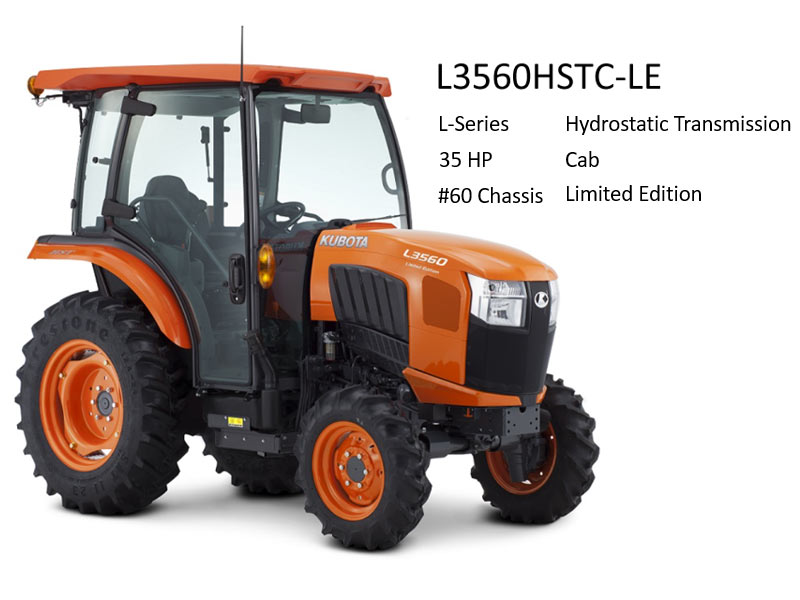Wondering what your Kubota model number means? It’s actually a code assembled from several parts that refer to different things. Here’s what each letter or number means from left to right.
Kubota Series Identification
The model number starts with a letter, which designates which series the tractor belongs to. Kubota offers only a few current series classifications: B, L, and M.
Kubota B Series – 20hp to 30hp subcompact tractors designed for lawns and small farms.
Kubota L Series – versatile compact tractors for heavier work, the L series ranges from 30hp to 60hp
Kubota M Series – heavy-duty workhorses designed for commercial use, the M series boasts 40hp – 145hp.
X Variations – if any series identifier is followed by an X, it is the smallest tractor in the line. BX tractors are 20hp, LX tractors are 30hp, and MX tractors are 40hp.
HP Numbers
The next two numbers designate horsepower and it’s a little deceptive. Horsepower ratings are not exact; the actual hp is a couple of points lower. You’d assume the Kubota B2301 model, for example, has 23hp, but it actually has 20.9 gross hp. Still, it’s a good approximate.
Chassis Numbers
Finally, the last two numbers on the end identify the chassis, and that’s where all rhyme and reason go out the window. For the last 15 years or so, the numbers have been more standardized. Before that, it’s anybody’s guess.
If your tractor is less than 15 years old:
- Older B Series chassis numbers are 20 or 50
- New B Series chassis numbers are 00 or 01
- BX Series chassis numbers are 50, 60, or 70
- Grand L Series chassis numbers are 30, 40, or 60
- Standard L Series chassis numbers are 00 or 01
- MX Series chassis numbers are 00
- M Series chassis numbers are 60, X or GX (X and GX are 100hp or higher)
Nothing confusing about that…
Note: These are identification codes for Kubota USA. Kubota series tractor identification numbers in other countries are slightly different. For example, if you run across a listing for a Kubota M4072 with 74hp, it’s a European model.
Tractor Variation Codes
Once you get beyond the basic model number, you may find codes in your paperwork or painted on the fender that provide extra information for that specific tractor. This information includes whether it’s two wheel drive (2WD) or four wheel drive (4WD), type of transmission, whether it has a cab, and more. Naturally, the more specialized the tractor, the more possible variations might be identified. While there is some overlap, in most cases, letter codes are different for the different series. For example, in the B series, 2WD is indicated by the letter E, and in the M series, an F identifies 2WD.
Position also matters in some cases. Letters that come at the end of the string after a dash can have a different meaning. TLB is tractor, loader, backhoe, while -T indicates that it’s a specialty tractor made for towing (primarily used in airports).
A few basic codes are generally the same on all models:
- C means cab model
- CS means creep speed
- D or DT means four wheel drive (4WD)
- E or F means two wheel drive (2WD)
- HST means hydrostatic transmission
- GST means glide shift transmission
- N means narrow tread (mostly used in orchards or vineyards)
- LE means Limited Edition
Here’s the big list for each tractor type:
| B Series Lettters | What it Means |
| D or DT | dual traction (4WD) |
| E | 2WD |
| HS | hydrostatic transmission |
| B | bi-speed turn |
| -T | tow tractor |
| TL | tractor, loader |
| TLB | tractor, loader, backhoe |
| BX Series Letters | Meaning |
| LB-R | loader, backhoe, with R4 tires |
| LB-T | loader, backhoe, with turf tires |
| R | R4 industrial tires |
| T | turf tires |
| V | loader valve |
| L Series Letters | What it Means |
| DT | dual traction (4WD), also sometimes written as double traction |
| DTC | dual traction (4WD), cab model |
| DTCCS | dual traction (4WD), cab model with creep speed |
| DTN | dual traction (4WD), narrow width specialty tractor |
| DTS | dual traction (4WD), power steering |
| DTSC | dual traction (4WD), power steering, two stage clutch, live continuous running PTO |
| DT-W | dual traction (4WD), wet clutch (Everclutch) |
| F | 2WD |
| FC | 2WD, live continuous running PTO |
| FS | 2WD, power steering |
| FSC | 2WD, live continuous running PTO, power steering |
| FST | fully synchronized transmission |
| GST | glide shift transmission |
| GSTC | glide shift transmission, cab model |
| GSTCA | glide shift transmission, 4WD, cab model with air ventilation kit |
| HC | high clearance |
| HDT | hydraulic shuttle, dual traction (4WD) |
| HDT-W | hydraulic shuttle, dual traction (4WD), wet clutch |
| HF | hydraulic shuttle, 2WD |
| HSTC | hydrostatic feather step transmission, cab model |
| M | mechanical shuttle |
| SS | shuttle shift |
| T | tow tractor |
| TL | tractor, loader |
| TLB | tractor, loader, backhoe |
| W | wide tread for row crop applications |
| M Series Letters | What it Means |
| DS | dual speed |
| C | cab model |
| DT | dual traction |
| M | mudder (specialty, for row crop or vegetable) |
| N | narrow tread (specialty, for orchard or vineyard) |
| -B | bi-speed turn |
| -1 | large two pump hydraulic system |
| F | 2WD |
| -CS | creep speed |
| C | cab model |
| H | 2WD |
| HC | 2WD, cab model OR high clearance |
| HD | hydraulic shuttle |
| L | low profile |
| M | mechanical shuttle |
| OC | orchard model |
| S | Synchro Shuttle transmission |
| SU | special utility, 2WD |
| SD | Swing Shift transmission |
| CC | cab model with cold weather package |
| -F | foldable ROPS |
| -R | rigid ROPS |
| -TF | turf special |
| W | wide row |
Sources: orangetractortalks.com, kubotausa.com
Putting it all Together
Say you’re looking at tractors and you come across a L3560HSTC-LE. Now you know it’s an L-Series, 35hp, on a #60 chassis. It has a hydrostatic transmission, a cab, and it’s a limited edition. Simple! Ok, maybe not so simple, but at least you can figure out what you’re looking at.
One last thing to note. Attachments have their own identification codes that have nothing to do with the tractor itself. If you see a code on an attachment, it only refers to the attachment.
Confused? Call us, we’ll help you sort it out.









